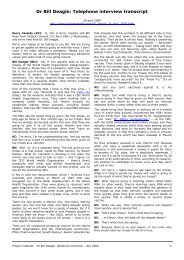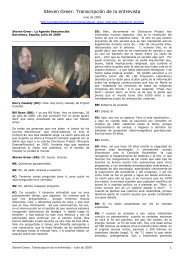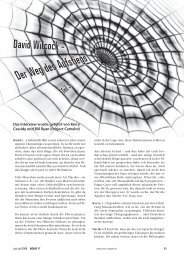The 'New Berlin' base: Nazis in the Antarctic - Project Camelot
The 'New Berlin' base: Nazis in the Antarctic - Project Camelot
The 'New Berlin' base: Nazis in the Antarctic - Project Camelot
Sie wollen auch ein ePaper? Erhöhen Sie die Reichweite Ihrer Titel.
YUMPU macht aus Druck-PDFs automatisch weboptimierte ePaper, die Google liebt.
<strong>the</strong> room. So when you use an correct room-mechanics-<strong>The</strong>ory you maybe get <strong>the</strong> correct results for <strong>the</strong> mov<strong>in</strong>g of <strong>the</strong> Universe<br />
through <strong>the</strong> room. This I have tried to do here.<br />
By do<strong>in</strong>g this I was able to get an easy s<strong>in</strong>us-function for <strong>the</strong> mov<strong>in</strong>g of <strong>the</strong> room through <strong>the</strong> e<strong>the</strong>r. That was years-long hard<br />
work! I had to learn many th<strong>in</strong>gs about physics before I was able to do that. But I really wanted to know what’s all about with <strong>the</strong><br />
th<strong>in</strong>gs <strong>the</strong>y have teached me at home. That is why I have engaged me with <strong>the</strong>se problems <strong>in</strong> <strong>the</strong> past very often. Now I th<strong>in</strong>k<br />
that I have found <strong>the</strong> same equations <strong>the</strong> o<strong>the</strong>rs <strong>in</strong> our home had.<br />
How I was able to get this S<strong>in</strong>us-equation for <strong>the</strong> mov<strong>in</strong>g of <strong>the</strong> Universe through <strong>the</strong> e<strong>the</strong>r you can see at <strong>the</strong>se equations<br />
(Many of <strong>the</strong> th<strong>in</strong>gs you can read here I have out of usual physic-books. Not everyth<strong>in</strong>g seemed to be wrong what you can read<br />
<strong>the</strong>re!):<br />
s(t) = ½ a t 2<br />
v(t) = a t<br />
With s = Length of <strong>the</strong> way you have moved with <strong>the</strong> velocity v, v = Your velocity, a = your acceleration. At <strong>the</strong>se equations you<br />
can see now that <strong>the</strong> Length of <strong>the</strong> wave also can be:<br />
v(t) = ∫ a(t)<br />
s(t) = ∫ ∫ a(t)<br />
and also :<br />
s(t) ’ = v(t)<br />
s(t) ’’ = a(t)<br />
With <strong>the</strong> help of <strong>the</strong>se functions s(t) and v(t) you can calculate now way- or velocity-functions who are not ½ a t 2 or a• t, but<br />
someth<strong>in</strong>g else. For example <strong>the</strong>y also can be ½ a t 4 or s<strong>in</strong>(t) or cos(t).<br />
Now look at <strong>the</strong> force who plays <strong>the</strong> most important part <strong>in</strong> <strong>the</strong> whole Universe. Of course this force is <strong>the</strong> gravitational<br />
<strong>in</strong>teraction. Because she holds all masses <strong>in</strong> <strong>the</strong> Universe toge<strong>the</strong>r. <strong>The</strong> gravitation force is:<br />
FGravitation = G M m , with G = Gravitational Constant, M = Whole mass <strong>in</strong> <strong>the</strong> Universe, m = Mass of an<br />
R 2 object <strong>in</strong> <strong>the</strong> room, R = Distance between M and m, F = Force between M and m<br />
FGravitation = G M m = a m , because F = m a (mass multiplicated with <strong>the</strong> acceleration of <strong>the</strong> mass)<br />
R 2<br />
FGravitation ≈ G • (M = <strong>in</strong> <strong>the</strong> <strong>in</strong>teraction <strong>in</strong>volved mass < range of <strong>the</strong> field) • m • (room-mechanic-effects)<br />
(R = distance) 2<br />
In this equation is:<br />
{Range of <strong>the</strong> field}<br />
G M m ≈ ∫ G • M(β) • m • dβ<br />
R 2 R(β) 2<br />
To f<strong>in</strong>d out how big M(β) and R(β) are <strong>in</strong> this equation, you must f<strong>in</strong>d out how big <strong>the</strong> Gravitation-field <strong>in</strong> <strong>the</strong> Universe really is.<br />
To f<strong>in</strong>d out all that, of course you must consider that <strong>the</strong> 3-dimensional room <strong>in</strong> a Universe is <strong>the</strong> surface of an 4-dimensional<br />
hollow-ball. If all that still is an physical fact or not doesn’t matter. For gett<strong>in</strong>g <strong>the</strong> correct gravitation-field for an s<strong>in</strong>-function for<br />
<strong>the</strong> mov<strong>in</strong>g of <strong>the</strong> Universe you must guess that <strong>the</strong> whole room has <strong>the</strong> form of an 4-dimensional hollow-ball. O<strong>the</strong>r cases can’t<br />
be correct, because you get <strong>the</strong>re wrong results for <strong>the</strong> field. So it must be an two-planed hollow-ball like <strong>the</strong>y have told it me <strong>in</strong><br />
our <strong>base</strong>. How big <strong>the</strong> gravitation-field <strong>in</strong> such a room always is, you can see at this picture:<br />
4<br />
2<br />
dM(β) 1<br />
3<br />
room s(t)= r β (range of <strong>the</strong> field)<br />
s<strong>in</strong>(β) r<br />
β ( “ )<br />
357<br />
mass m<br />
dM(β)<br />
In this curved field is now <strong>the</strong> field-Distance (dM(β); m) not β /360° • r (way along <strong>the</strong> curved surface), but ≈ s<strong>in</strong>(β)• r. <strong>The</strong> reason<br />
for that is, that <strong>the</strong> field of dM(β) achieves <strong>in</strong> m as if it would come from a po<strong>in</strong>t who has only <strong>the</strong> distance s<strong>in</strong>(β) r from m. All<br />
that you can measure at <strong>the</strong> diameter of <strong>the</strong> field-hollow balls who arrive at m. <strong>The</strong>ir diameter is not β /360° • r, but only s<strong>in</strong>(β)• r.<br />
All that is why <strong>the</strong> Gravitation-Potenzial between m and dM(β) is:<br />
Gravitation-Potenzial between dM and m is: G dM m _1_<br />
s<strong>in</strong>(β)<br />
Gravitation-Force between dM and m is: G dM m cos(β) , F(r) = d M<br />
s<strong>in</strong>(β) 2 dr r









